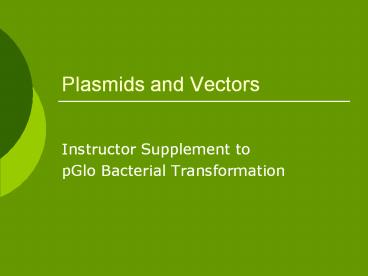Plasmids and Vectors - PowerPoint PPT Presentation
Title:
Plasmids and Vectors
Description:
Plasmids and Vectors Instructor Supplement to pGlo Bacterial Transformation A more detailed look at plasmids Cloning into a Plasmid Asilomar Conference Screening ... – PowerPoint PPT presentation
Number of Views:1609
Avg rating:3.0/5.0
Title: Plasmids and Vectors
1
Plasmids and Vectors
- Instructor Supplement to
- pGlo Bacterial Transformation
2
A more detailed look at plasmids
3
Cloning into a Plasmid
4
(No Transcript)
5
Asilomar Conference
- People believed that safe strains of bacteria,
viruses and vectors could be made in a few weeks - NIH formed the Recombinant DNA Advisory Committee
(RAC) - It took 1 year (1976) before the first safe
(EK2 category) line of E. coli was released - That year, RAC released a set of guidelines
requiring the use of safe bacteria
6
NIH Guidelines
- Self Regulation in Science Milestone
- Contents
- Specified handling and construction processes
- Microorganisms containing recombinant DNA were
prohibited outside of the laboratory - Vectors that sexually move to unsafe bacteria
was prohibited - Subsequent modifications
- 1986 expanded to include animals and plants, and
4 biosafety levels - 1994 officially relinquished control of GMO
plants in the environment to EPA and APHIS
7
The First Safe Bacterium
- Released in 1976 by Roy Curtiss III at the
University of Alabama - E. coli ?1776
- Required diaminopimelic acid (DAP)
- Fragile cell walls (low salt, detergent
sensitive) - Difficult to work with
- Slow grower
- Poor receptor for transformation
8
In the 1970s and 1980s
- The first cloning vectors such as pSC101 had
limited functionality - The next trend was to develop smaller plasmids
- Advantages
- Increased efficiency of transformation
- Easier to restriction map
- Higher copy numbers
9
The Cadillac of Cloning Vectors
- pBR322
- Clone fragment in one antibiotic gene
- Select for other antibiotic resistance
- Screen for presence of one resistance gene
(selects against untransformed bacteria) and loss
of resistance to interrupted antibiotic
resistance gene (selects for recombinant molecule)
EcoRI
TetR
AmpR
pBR322 4,361 bp
APstI
BamHI
10
Screening bacteria by replica plating
11
Next Major Advance in Plasmid(ology)
- The inclusion of polylinkers into plasmid vectors
- Polylinker is a tandem array of restriction
endonuclease sites in a very short expanse of DNA - For example, pUC18s polylinker
- Sites for 13 REs
- Region spans the equivalent of 20 amino acids or
60 nucleotides
Source Bio-Rad Laboratories
12
The Polylinker Advantage
- Unique sites (usually)
- Insert excision facilitated
- Restriction endonuclease mapping and Subcloning
made easier
13
Another Major Advance Blue-White Screening
14
Features of many modern Plasmids
- Small size
- Origin of replication
- Multiple cloning site (MCS)
- Selectable marker genes
- Some are expression vectors and have sequences
that allow RNA polymerase to transcribe genes - DNA sequencing primers
15
The Major Limitation of Cloning in Plasmids
- Upper limit for clone DNA size is 12 kb
- Requires the preparation of competent host
cells - Inefficient for generating genomic libraries as
overlapping regions needed to place in proper
sequence - Preference for smaller clones to be transformed
- If it is an expression vector there are often
limitations regarding eukaryotic protein
expression
16
Bacteriophage lambda (?)
- A virus that infects bacteria
- In 1971 Alan Campbell showed that the central
third of the genome was not required for lytic
growth. People started to replace it with E.
coli DNA
17
Lambda genome is approximately 49 kb in
length. Only 30 kb is required for lytic
growth. Thus, one could clone 19 kb of foreign
DNA. Packaging efficiency 78-100 of the lambda
genome.
A complete animation of the lytic
cycle http//www.blackwellpublishing.com/trun/art
work/Animations/Lambda/lambda.html
18
Bacteriophage lambda
- Protein capsule of lambda has a tight constraint
on the amount of DNA that will fit inside it (
55kb) - By the early 1970s we knew that a good portion
of lambda was not required - Junk DNA
COS site Cohesive sticky ends
Lysis
Head
Replication
ori
Tail
Circularized lambda
Lysogeny
19
Not Quite Bacteriophage lambda
- Eliminate the non-essential parts of lambda
- Can now insert large pieces of DNA ( 20 kb)
20
(No Transcript)
21
Lambda was great
- Larger insert size
- Introducing phage DNA into E.coli by phage
infection is much more efficient than
transforming E.coli with plasmid DNA
But
- Have to work with plaques
22
Cosmids
- Hybrid vectors plasmids that contain
bacteriophage lambda cos sites - DNA ( 33-48 kb) cloned into restriction site,
the cosmid packaged into viral particles and
these phages used to infect E.coli - Cosmid can replicate in bacterial cell, so
infected cells grow into normal colonies - Insert DNA limited by the amount of DNA that can
fit into phage capsule - Somewhat unstable, difficult to maintain
23
Other Vectors
- BACs (Bacterial artificial chromosomes)
- Large low copy number plasmids (have ori and
selectable marker) - Can be electroporated into E. coli
- Useful for sequencing genomes, because insert
size 100 - 300kb - YAC (Yeast Artificial Chromosome)
- Can be grown in E.coli and Yeast
- Miniature chromosome (contains ori, selectable
markers, two telomeres, and a centromere - Can accept 200 kb -1000 kb useful for sequencing
- Ti plasmids to introduce genes into plants
- Expression vectors
24
How do you identify and clone a gene of interest?
- Screen A DNA library
- Genomic
- cDNA
- Use Polymerase Chain Reaction (PCR) to clone gene
of interest
25
Genomic Library
26
cDNA library
27
What can you do with a library?
- Can be used to complement a mutant (this is more
common for research in bacteria). - Can use it in a colony hybridization.
28
Screening libraries by colony hybridization
29
Polymerase Chain Reaction (PCR)
30
(No Transcript)
31
Agarose gel electrophoresis
32
Restriction Mapping
33
(No Transcript)































